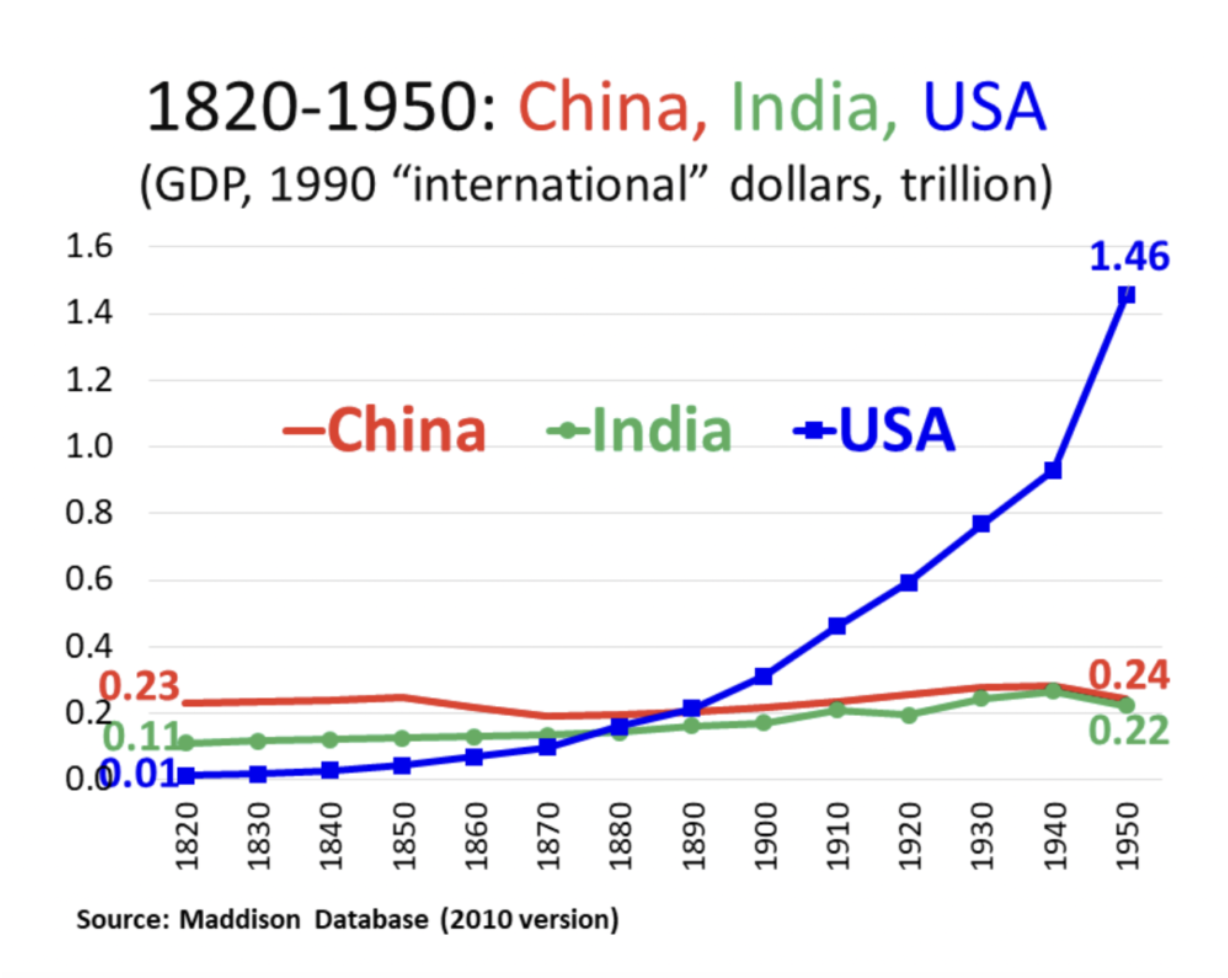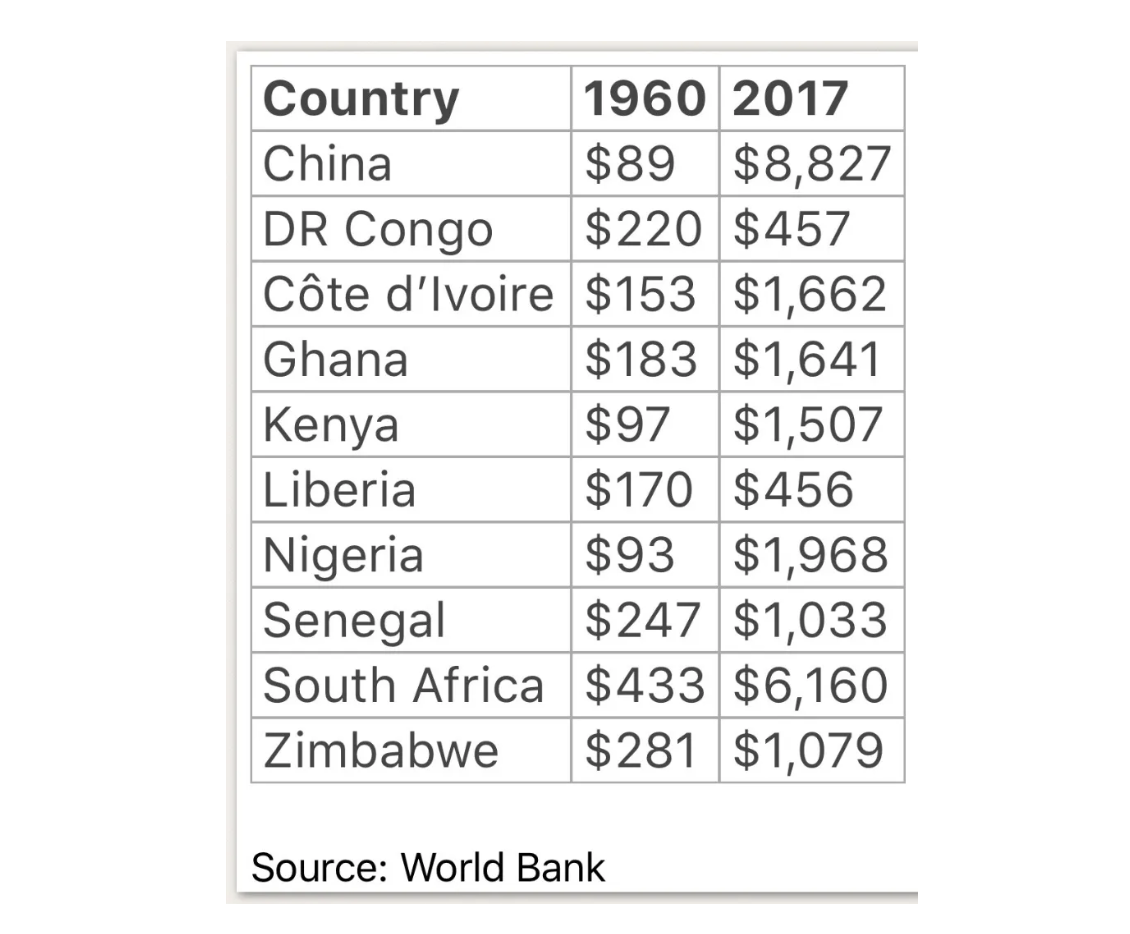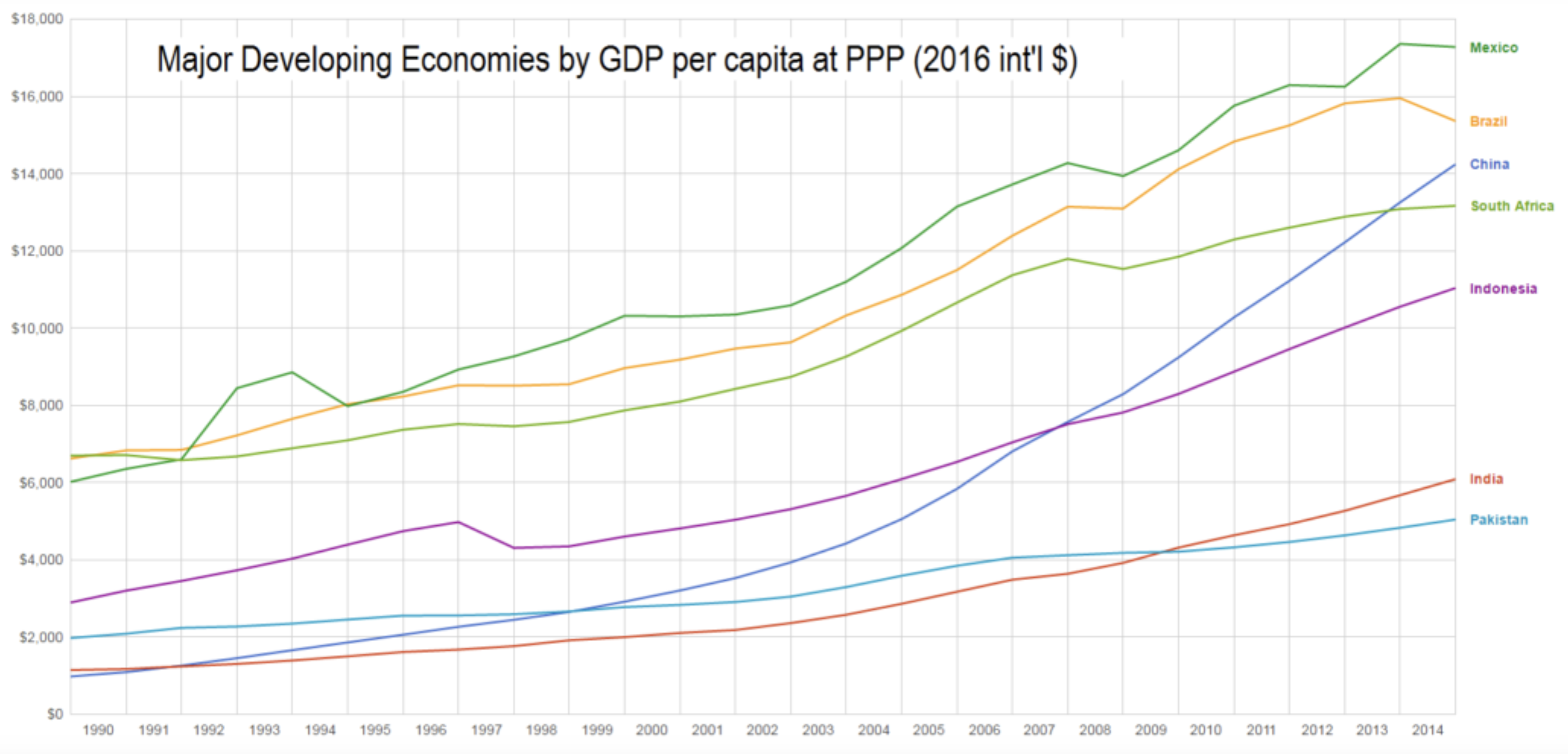https://johnmenadue.com/america-bombs-while-china-builds/?
作者:Richard Cullen  理查德·卡倫 2024年5月1日,香港大學法學院兼職教授。他曾擔任澳大利亞墨爾本莫納什大學商業法和稅務係教授。
理查德·卡倫 2024年5月1日,香港大學法學院兼職教授。他曾擔任澳大利亞墨爾本莫納什大學商業法和稅務係教授。
有時侯,有人說,美國在轟炸,而中國在建設。證據是什麽?統計數據在哪裏?讓我們來看看美國和中國在當今世界上顯而易見的廣泛全球足跡的起源和性質。
一百多年前,美國已成長為舉世矚目的超級大國。
三百年前,中國也占據著特別主導地位——盡管與美國相比,其財富和權力仍然更加集中在中國境內。
隨著西方領導的殖民時代無情且有效地向全球各個角落推進,中國隨後成為一個被嚴重削弱和嚴重征服的實體。
然而最近,中國的非凡崛起以前所未有的方式扭轉了這一頹勢。而美國衰敗跑進入頹勢。
名義GDP 數據以現價美元計算 資料來源:世界銀行
起點
1700年之後,中國在全球的足跡大幅萎縮,當時中國占全球經濟總量的22%以上。一個多世紀後的1820年,中國的經濟規模仍然是剛剛起步的美國的23倍,但經濟正在下滑。
1949年10月,中華人民共和國(中華人民共和國)在北京成立時,中國極度貧困,人口約5.4億,GDP僅約25億美元。
當時,非常富裕的美國人口約為1.5 億,GDP為1.46萬億美元 — — 或者說,按原始 GDP 計算,其經濟規模幾乎是中國的600倍,請參見:
中國經濟:曆史透視與未來展望。
就在1960年,中國還比許多非洲國家還窮。
美國擴大其全球足跡
第二次世界大戰後,美國的實力在世界範圍內以驚人的速度增長。它的軍事實力本來就很強大,但在開支超過接下來10個國家的總和的推動下,它的軍事實力不斷擴大。
(看這個鏈接:爭取優先考慮和平、經濟安全和共同繁榮的美國聯邦預算。
隨著美國經濟在 2010 年占全球 GDP 的 33% 以上,其全球經濟主導地位也保持同步。美國大力推銷的軟實力確保了其在全球意識形態、媒體、娛樂和文化方麵的巨大影響力。
1991年柏林牆倒塌、蘇聯解體後,美國:首先強調冷戰勝利;接下來,製定了一項秘密計劃,以確保沒有其他國家能夠再次挑戰美國的霸權(參見:
美國的戰略計劃要求確保沒有競爭對手發展。
美國的全球足跡是巨大的。而且它在軍事上是很強調的。美國圍捕了一批順從的盟友,並帶領他們卷入許多殘酷的戰爭,例如在朝鮮、越南、巴爾幹、伊拉克、利比亞和阿富汗。
如今,美國及其合作者主要通過代理人,在烏克蘭和不可原諒的加沙卷入了精心策劃的可怕戰爭——這是自盧旺達以來最嚴重的種族滅絕戰爭。美國幾乎總是與全球各地的各種敵人交戰,而這些敵人都為美國領導的軍事工業媒體綜合體(MIMC)帶來了豐厚的持續利潤。
為什麽美國總是在某個地方打仗?
中國不斷變化的全球足跡
1949年之後的三十年裏,中國的大部分時間都在苦苦掙紮。首先是繼承的、大規模的貧困和落後造成的可怕影響。 此外,北京還必須應對嚴重的外部威脅,特別是朝鮮戰爭以及美國在 20 世紀 50 年代與國民黨聯合支持台灣重新點燃內戰的傾向。 接下來是嚴重破壞性的國內災難,其中最嚴重的是毛澤東大躍進(1958年至1962年)造成的經濟破壞和饑荒,以及文化大革命(1968年至1978年)造成的嚴重破壞。
但明智的頭腦明白,美國在19世紀從一個以奴隸製為主的農業經濟體,在大約 100 年內實現了非凡的崛起,成為主導世界的工業強國,這為中國提供了重要的教訓。 特別是,事實證明,如果以單一的焦點和決心,采用以現代形式創建並在歐洲啟蒙運動期間提升的科學方法並將其應用於現代工業化經濟的發展,可能會產生巨大的變革。
自 1978 年以來,特別是在鄧小平(如圖)的指導下,中國實際上是從頭開始重建自己,以人類曆史上前所未有的規模使用這一基本公式 — 特別是在這樣一個時期
時間跨度短。 因此,我們現在發現,美國的全球足跡不再隻有一個占主導地位,而是有兩個主要的全球足跡:美國和中國,這兩個足跡相互重疊。
然而,與美國最不同的是,自1979年(與越南發生短暫戰爭的一年)以來,中國在重建過程中選擇了幾乎完全避免戰爭。 這在很大程度上與2000多年的帝國曆史相一致,無論是在羅馬帝國滅亡之前還是之後,中國的回避戰爭都比歐洲更加明顯。參見:中國從來都不是一個帝國主義國家。 中國不轟炸,而是建設、建設、建設。 結果是驚人的,全世界都有目共睹。
1949年,中國和印度的國民生產總值數據大致相當。 根據日經亞洲最近的一份報告,如今,中國的經濟規模約為印度的五倍 請參閱:
如果印度經濟能夠保持在正軌上,它就能超越中國
中國現在是世界第二大經濟體(基於原始 GDP 數據)或世界第一大經濟體(基於購買力平價數據)(參見:解讀中國 GDP
此外,根據世界銀行的數據,過去40年來,超過8億中國人擺脫了赤貧。 中國的全球足跡在世界曆史上是無與倫比的。
還有非凡的“一帶一路”倡議(BRI)。 自2013年以來,中國一直在世界各地通過這一巨大的建設性項目建設最廣泛意義上的基礎設施(包括直接建設和協助建設)。 它無疑為中國帶來了經濟和核心軟實力利益,但它也為整個南半球國家帶來了經濟提升優勢:
“一帶一路”倡議如何促進中國利益?
在重要方麵,自19世紀及之前的華人僑民的巨大足跡預示著“一帶一路”的成功:
海外華人如何為“一帶一路”鋪平道路
概要
如今,中國約占全球GDP的18%,這一比例仍在上升,而美國約占全球 GDP 的25%,低於2010年的33%以上。
未來十年中國GDP怎樣才能增長4%至5%?
美國經濟在全球的影響力仍然非常重要。但如今,美國選擇超越世界的可怕方麵卻給它蒙上陰影。任何公開看待我們所有人目前麵臨的地緣政治緊張局勢的人都會遇到一些核心例子。
美國炸彈和獾
美國現在正以巨大成本為其與俄羅斯戰鬥到底的決心進行再融資 烏克蘭見:
在歐洲最近一場可怕的戰爭中,戰鬥到最後一個烏克蘭人。
更可惡的是,美國正在大規模武裝以色列,以擴大其在加沙的報複性、陰謀性的種族滅絕,讓美國的腋下沾滿了巴勒斯坦人的鮮血,同時仍在向世界宣講人權的重要性。
道德受損的美國仍在揮舞正義的手指
美國不滿足於所有這些無恥的(營利的)戰爭販子,還正在組織新的、大規模的資金注入台灣軍隊,以表明如果需要的話,美國願意與中國進行熱戰(無知的順從的盟友會采取行動) 筆記)。
這在一定程度上是為了確保台灣成為美國控製的、毗鄰中國的巨大軍事橋頭堡(不用擔心對台灣造成的後果),最重要的是,為了幫助扭轉現代中國的崛起。
在所有這些情況下,從七國集團和五眼聯盟中大量抽調而來的聽話領航魚群體以各種方式做出反應,包括:為放血歡呼(在烏克蘭);轉移他們的目光;點頭同意; 偶爾還抓著他們的珍珠。可以預見的是,全球西方的主要媒體喉舌將所有這些行為視為神聖的保護民主和人權的努力參見:
新聞迷必備的媒體術語指南
出於這些原因,世界其他地區,除了西方世界之外 — — 尤其是南方國家 — — 今天比以往任何時候都更加認為美國的全球足跡看起來極其虛偽、越來越惡毒且難以預測。 今天,即使是仍然反對統一的大多數台灣人(根據民意調查)也必須看到美國可能將台灣拖入一場戰爭的嚴重風險,而美國將無所畏懼地致力於戰鬥到最後一個台灣人。
談到這一點,有人最近指出,當華盛頓的精英們在北京握手確認他們支持一個中國政策時,他們常常感覺他們說話時另一隻手拿著槍瞄準。 這是當前中美一係列討論中顯而易見的模式。
中國建設
中國不斷增長的全球影響力也不斷引發這些高度政治化的例子之外的擔憂
由美國主導的環球西方及其媒體推動。但這些擔憂與中國如何塑造最終的貿易和融資框架有關,這對中國有利 — — 而對“一帶一路”沿線國家不利。
但“一帶一路”總體積極影響值得高度重視。 南方國家現在根據經驗知道,西方國家無法提供任何類似的援助。他們還記得2021年拜登與七國集團的“重建更美好世界”(B3W) 倡議。現在,西方國家基本上已經忘記了該倡議當時在全球範圍內的大力推廣。迄今為止,B3W 已被證明是,正如德克薩斯州所說:所有人都沒有牛。
與此同時,近150個國家(193 個聯合國成員國中)現已成為“一帶一路”成員國。中國對“一帶一路”成員國的投資最高時每年超過1000億美元,目前仍接近每年700億美元見:
一帶一路倡議 (BRI) – 統計數據與事實
拜登·邦格爾斯
最後,隨著下屆總統選舉的臨近,喬·拜登親自強調了對美國今天的全球足跡以及他自己的心態的擔憂。 他最近聲稱(與官方軍事證據相反),他的叔叔可能在第二次世界大戰期間被新幾內亞的食人者吃掉。 這讓世界各地,尤其是南半球國家感到震驚,在這些國家,食人族的刻板印象被證明是一種破壞友誼的舉動。
巴布亞新幾內亞總理詹姆斯·馬拉佩覺得他別無選擇,隻能告訴美國全球足跡的總司令:巴布亞新幾內亞人民沒有吃掉你的叔叔拜登先生看:
領導人告訴拜登,巴布亞新幾內亞人民沒有吃你的叔叔
結論
中國有著極其悠久、連續、有記載的曆史。今天的北京深刻地理解了曆史的重要性。 北京不斷研究、借鑒。 通過如此密切關注這一相關的、長期的曆史,我們學到的一個主要教訓是,為什麽保持穩健、消息靈通的衝動控製至關重要。 另一個原因是,貿易幾乎每一次都戰勝了戰爭。
美國似乎在研究其整個、較短但仍然非常獨特的曆史上投入的精力要少得多,以便能夠從自己的、往往是血腥的、主要的國家經曆中吸取全麵的教訓(而不僅僅是如何保持第一)。
華盛頓似乎也不太重視北京的衝動控製。 坦率地說,這會嚴重阻礙你找到解決方案,再次。
America bombs while China builds
https://johnmenadue.com/america-bombs-while-china-builds/?
By Richard Cullen  May 1, 2024, Adjunct Professor in the Faculty of Law at the University of Hong Kong. He was previously a Professor in the Department of Business Law and Taxation at Monash University in Melbourne, Australia.
May 1, 2024, Adjunct Professor in the Faculty of Law at the University of Hong Kong. He was previously a Professor in the Department of Business Law and Taxation at Monash University in Melbourne, Australia.
It is sometimes said that America bombs while China builds. What's the evidence, and where are the statistics?
Let's examine the origin and nature of the broad global footprints of America and China which are evident across the world today.
The US grew to become a world-striding superpower over 100 years ago.
Three hundred years ago, China was also particularly dominant – though its wealth and power remained far more locally concentrated, within China, compared to the US.
China subsequently became a vastly weakened and significantly subjugated entity as the Western-led colonial era advanced relentlessly and effectively to all corners of the globe.
Nominal GDP figures are in current US$ Source: The World Bank
More recently, however, the extraordinary rise of China has reversed this decline in an unprecedented manner.
STARTING POINTS
China's global foot print shrunk massively after the year 1700, when it comprised over 22% of the total global economy. More than a century later, in 1820, China still retained an economy that was 23 times larger than that of the fledgling US but the slide was underway.
When the People's Republic of China (PRC) was established in Beijing, in October 1949, deeply impoverished China, with a population of around 540 million, had an emaciated GDP of around US$ 2.5 billion.
At that time, the very rich US had a population of around 150 million and a GDP of US$1.46 trillion – or an economy that was almost 600 times larger than that of the PRC, measured in raw GDP terms see:
China’s Economy: Historical Perspective and Future Outlook.

As recently as 1960, China was poorer than many African nations.

AMERICA AMPLIFIES ITS GLOBAL FOOTPRINT
America power grew, worldwide, at an exceptional rate after World War II. Its military strength, already huge, simply kept expanding driven by spending exceeding that of the next 10 countries combined.
(Look at this link: Fighting for a U.S. federal budget that prioritises peace, economic security and shared prosperity.
Its global economic dominance kept pace as the US economy advanced to comprise over 33% of Global GDP by 2010. America’s intensely marketed soft-power ensured tremendous worldwide ideological, media, entertainment and cultural influence.

After the Berlin Wall came down and the USSR was dissolved in 1991, the US: first emphasised its victory in the Cold War; and, next, produced a secret plan to ensure that no other nation could ever challenge American hegemony again (see:
US strategy plan calls for insuring no rivals develop.
America's global footprint was huge. And it was militarily emphatic. The US rounded-up its posse of obedient allies and led them into many brutal wars in, for example, Korea, Vietnam, the Balkans, Iraq, Libya and Afghanistan.
Today the US and its collaborators are engaged, mainly by proxy, in calculated horrific wars in Ukraine and, unforgivably, in Gaza – the worst genocidal war since Rwanda. The US is almost always at war with varied-enemies right around the globe, which, in each case, delivers rich continuous profits to the US-led, Military-Industrial-Media-Complex (MIMC) See:
Why is the United States always fighting a war somewhere?
CHINA’S EVOLVING GLOBAL FOOTPRINT
China struggled desperately for most of three decades after 1949. First there was the dire impact of inherited, massive poverty and backwardness. Plus, Beijing had to address severe external threats evident particularly in the Korean War and the American tilt towards supporting a re-igniting of the Civil War from Taiwan jointly with the Kuomintang, in the 1950s. Next came gravely damaging home-created catastrophes, worst of all being the economic wreckage and famine arising from Mao Zedong’s Great Leap Forward (1958 – 1962) followed by intense destructiveness unleashed by the Cultural Revolution (1968 – 1978).
But wise heads understood that America’s extraordinary rise from a being a significantly slave-based, agricultural economy during the 19th century into an industrial, world dominating powerhouse within around 100 years carried primary lessons for China. In particular, the proof was there that taking the scientific method created in its modern form and elevated during the European Enlightenment and applying it to the development of a modern industrialised economy could be exceptionally transformative on a huge scale, if done with singular focus and determination.
Since 1978, guided especially by Deng Xiaoping (pictured), China has rebuilt itself virtually from the ground up, using this essential formula on a scale never before seen in human history – especially over such a short time span. Thus, we now find that there is no longer just one dominant American global footprint – but two primary global footprints, American and Chinese, which overlay each other.
However, most unlike the US, China has chosen to avoid warfare almost completely since 1979 (the year of a brief war with Vietnam) as it rebuilds itself. This is largely consistent with over 2000 years of Imperial history, where war-avoidance by China was notably more apparent than in Europe, both before and after the fall of the Roman Empire See: China was never an imperialist state At the most fundamental level, China doesn’t bomb – it builds and builds and builds. And the results, which are astonishing, are there for all the world to see.
In 1949, China and India each had national GDP figures that were about equal. Today, China’s economy is around five times larger than that of India according a recent Nikkei Asia report See:
India's economy can overtake China's if it can stay on track
China now has the second largest economy (based on raw GDP figures) or the largest economy in the world (based on Purchasing Power Parity figures) (see: Unpacking China's GDP
Moreover, more than 800 million Chinese have been lifted out of abject poverty over the last 40 years, according to the World Bank. This aspect of Chinese global footprint is simply unmatched in world history.
Then there is the extraordinary Belt and Road Initiative (BRI). Since 2013, China has been building infrastructure in the widest sense (both directly and by facilitation) around the world, pursuant to this huge, constructive project. It has certainly provided economic and core soft-power benefits for China, – but it has also delivered economy-lifting advantages across the Global South See:
How Is the Belt and Road Initiative Advancing China's Interests?
In important ways, the success of the BRI was foreshadowed by the remarkable, very large footprint of the Chinese diaspora dating back to the 19th century and before See:
How the Chinese diaspora paved the way for BRI
A SYNOPSIS
China today accounts for around 18% of Global GDP, a share which is still rising and the US accounts for around 25% of Global GDP, – down from over 33% in 2010 See:
What Will It Take for China's GDP to Grow at 4–5 Percent Over the Next Decade?
This US economic global footprint is still immensely significant. But is, today, overshadowed by horrific aspects of how America chooses to bestride the world. Some central examples confront anyone looking openly at the geopolitical tensions presently facing us all.
America Bombs and Badgers
The US is now refinancing, at huge cost, its determination to fight Russia to the last Ukrainian See:
Fighting to the last Ukrainian in Europe’s latest terrible war.
Even more obscenely, America is massively arming Israel to amplify its vengeful, scheming genocide in Gaza, leaving the US covered to the armpits in Palestinian blood while it still lectures the world on the importance of human rights See:
Morally damaged America still wagging its righteous finger
Not satisfied with all this shameless (profit-generating) war-mongering, the US is also organising fresh, very large financial injections into Taiwan’s military to signal US willingness to engage in a hot war with China, if needs be (witless obedient allies take note).
This is partly to secure Taiwan as a vast, permanent US-controlled military bridgehead adjacent to China (never-mind the consequences for Taiwan) and, above all, to help reverse the rise of modern China.
In all these cases, the obedient posse of pilot fish heavily drawn from the G7 and the Five Eyes respond in a variety of ways including: cheering on the blood-letting (in Ukraine); averting their gaze; nodding agreement; and occasionally clutching their pearls. Predictably, the primary media mouthpieces across the Global West market all of this behaviour as sanctified striving to protect democracy and human rights See:
An essential news junkie's guide to media terminology
For these reasons, most of the Rest of the World, outside of the Global West – and especially in the Global South – today, more than ever, perceive a menacing American global footprint that looks incandescently hypocritical, increasingly malevolent and dangerously unpredictable. Even the majority in Taiwan who remain opposed to reunification (according to opinion polls) must, today, see the acute risk that America could drag Taiwan into a war where the US fearlessly commits itself to fighting to the last Taiwanese.
Speaking of which, someone recently noted how, when Washington elites confirm with a handshake that they support, for example, the One China policy, in Beijing, it regularly feels like they are aiming a gun with the other hand as they talk. This is a pattern evident in a range of current Sino-American discussions.
China Builds
China’s growing global footprint also prompts concerns outside of those highly politicised examples constantly promoted by US-led, Global West and its media outlets. But these are concerns related, for example, to how China may shape ultimate trade and financing frameworks to China’s advantage – and to the disadvantage of BRI client-nations.
However, the overall positive impact of the BRI is deeply valued. And the Global South now knows, from experience, that the Global West can offer no remotely comparable assistance. They remember the Biden-G7, Build Back Better World (B3W) initiative from 2021. Now largely forgotten within the West it was heavily marketed, globally, at the time. The B3W has thus far proved to be, as they say in Texas: All hat no cattle.
Meanwhile, almost 150 countries (out of 193 UN member states) are now BRI members. China’s BRI investment in member states peaked at over US$100 billion per year and it still amounts to almost US$70 billion per year See:
The Belt and Road Initiative (BRI) – statistics & facts
Biden Bungles
Finally, Joe Biden personally amplified concerns about what the American global footprint portends today – and about his own state of mind, as the next Presidential Election approaches. He recently claimed (contrary to official military evidence) that his uncle may have been eaten by cannibals in New Guinea during World War II. This set heads shaking around the world and especially in the Global South, where cannibal-stereotyping is a proved friendship-termination move.
Prime Minister James Marape of Papua New Guinea felt he had no choice but to tell the Commander-in-Chief of America’s global footprint that: PNG people did not eat your uncle Mr Biden See:
PNG people didn’t eat your uncle, leader tells Biden
CONCLUSION
China has a remarkably long, continuous, recorded history. Beijing, today, understands how history matters deeply. Beijing studies it and draws on it continuously. One primary lesson learned from paying such close attention this relevant, extended history, is why maintaining robust, well-informed impulse control is of paramount importance. Another is that trade beats war, almost every time, with everyone.
America appears to apply far less effort to studying its entire, shorter but still highly distinctive history to enable it to draw the full range of lessons (not just how to stay Number One) from its own, often bloodied, primary national experiences.
Washington also seems to have scant regard for the sort of impulse control embedded in Beijing. Bluntly put, it gets seriously in the way of bombing your way to a solution. Yet again.
Republished from FridayEveryday, April 29, 2024




